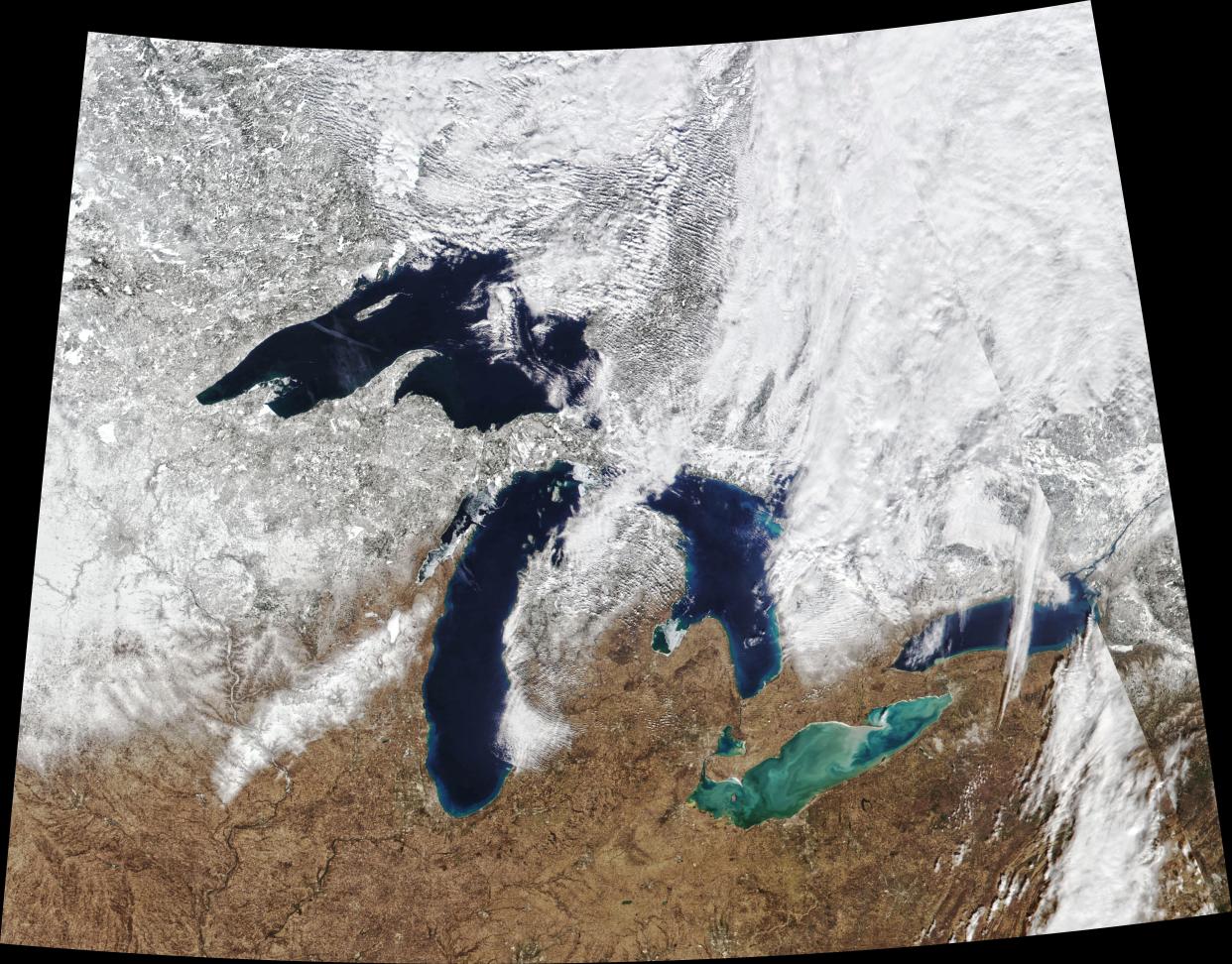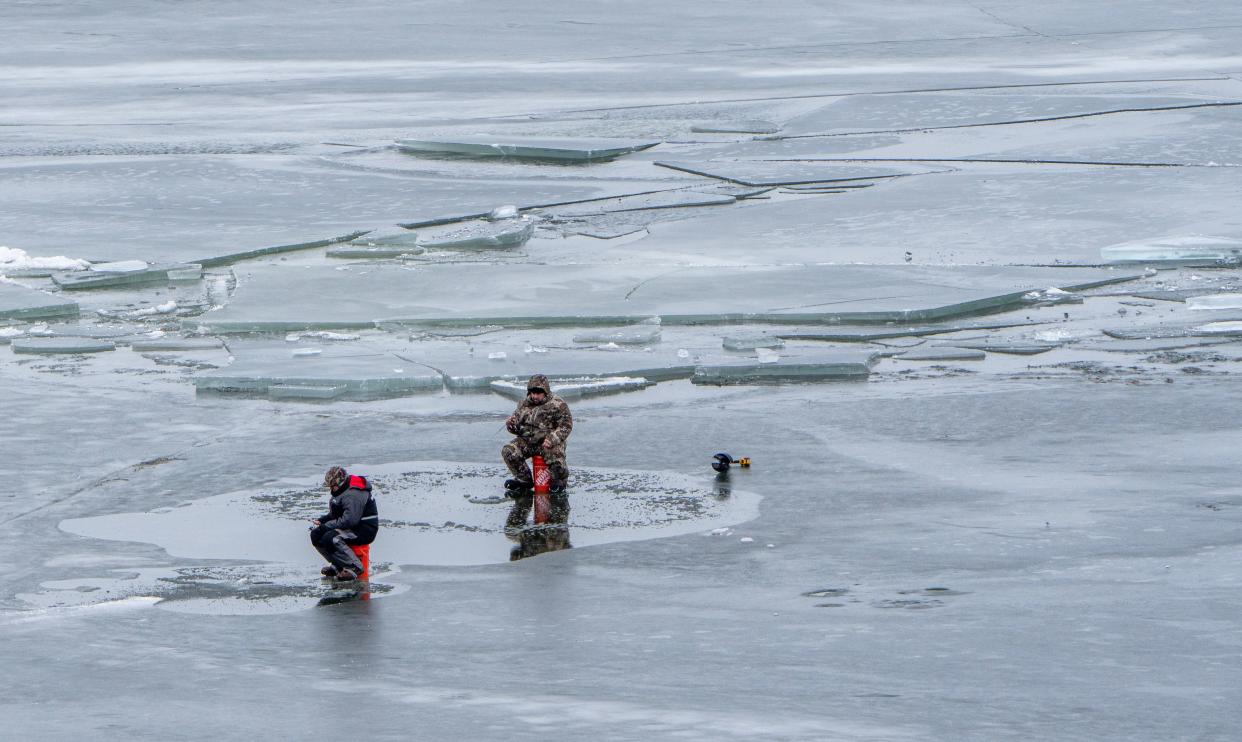Great Lakes ice season off to slowest start in 50 years of records. Why that matters.
Lake ice concentration is off to a slow start in the Great Lakes region, triggering harrowing rescues for fishermen who have ventured onto unsafe ice sheets.
It's the slowest beginning to ice formation in 50 years of recordkeeping, with an infinitesimal coverage of less than 1% on Jan. 1, according to the National Oceanic and Atmospheric Administration.
It is still only the very beginning of the ice season, but the 50-year average ice concentration across the five lakes for Jan. 1 is 9.45%, said Bryan Mroczka, a meteorologist with NOAA’s Great Lakes Environmental Research Laboratory. There’s no ice at all on Lake Erie or Lake Ontario.
The lakes typically hit their peak ice concentration in February or early March. This year, they're under the influence of a strong El Niño, bringing a short-term warming trend to the region, but scientists say evidence of the long-term climate change also can be seen in the region's ice formation trends. The year that just concluded was the Earth's hottest on record.
Ice rescues
Officials are warning anglers and other outdoor enthusiasts to carefully check conditions before getting on to the ice in lakes in the Great Lakes region, and to take safety precautions. Already this winter two ice-related fatalities have been reported in Minnesota and dozens of fishers have been rescued.
The biggest trouble so far has not been on the five Great Lakes but on Upper Red Lake in Northern Minnesota. It’s the largest inland lake in Minnesota, and also one of the shallowest, said Nicole Biagi, ice safety coordinator for the state’s Department of Natural Resources.
On Dec. 29, more than 120 anglers were stranded when an ice floe drifted away from the Upper Red Lake shoreline. The incident was one of four on the same lake since Dec. 17, including 35 ice fishers who were stranded and two ATV riders who fell through a patch of ice on the lake on Dec. 28.
Similar events happened the past two winters.
Lakes freeze first around the perimeter, and then freeze toward the middle, Biagi said. On Upper Lake that ice can look really thick and appear safe, but this winter even though the ice on the edges appears to be up to 10 inches thick, the middle of the lake is still open water.
When there's open water, strong winds can break the ice sheets on the edge, even if they're thick, and send them floating out toward the middle of the lake, she said. And that's what happened on Dec. 29.
The incident required a massive joint response, with several agencies coordinating to get people – but not all of their equipment and vehicles – off the ice, she said. “I think it only took about 2½ hours for them to complete the rescue, which is pretty amazing.”

El Niño gets partial blame
El Niño, a pattern of warmer than normal water in the Pacific Ocean, typically brings above normal temperatures to the Upper Midwest and Great Lakes, Mroczka said. The average temperature in Duluth, Minnesota in December was 13 degrees above normal, and in Marquette, Wisconsin, the average was 10.1 degrees above normal, the National Weather Service reported.
Given the weather forecast, the U.S. National Ice Center’s winter forecast calls for below normal ice conditions on all five lakes.
That doesn’t mean the region won’t see Arctic outbreaks, and some rapid periods of ice formation are likely as the region heads deeper into the winter, Mroczka said.
But overall, annual average ice concentration has been declining for decades, with shorter seasons that start later and end earlier. Ice coverage on the lakes has decreased an average of about 5% per decade, he said.
Great Lakes ice season getting shorter
In one study more than 20 years ago, researchers at the University of Madison-Wisconsin documented later freeze dates and earlier breakup dates for ice on lakes and rivers in the Northern Hemisphere dating at least as far back as 1846. Researchers also found similar patterns of ice seasonality for lakes in Japan and Finland, where ice observations were recorded as far back as 1443 in Japan and 1693 in Finland.
Ice concentration still fluctuates up and down in any given year on the Great Lakes, Mroczka said, but many Arctic outbreaks are shorter in duration than they used to be, lasting a few days rather than a week to 10 days.
The length of the ice season has “significantly decreased,” he said. From the time the ice first reaches 5% coverage to the last time it reaches 5% before thawing in the spring, the time frame has decreased by 46 days over the last 50 years.
“These are massive bodies of water, very deep, very large and they don’t freeze overnight,” he said. “In order to get good ice formation, you need a long period of cold air, to come in and get entrenched over the area.”
Shorter ice seasons bring a range of impacts, he said, with negative effects on erosion and tourism.
Historically ice protected shorelines around the lakes from erosion. When the ice arrives later, beaches, roads and other infrastructure are more exposed to high winds and large waves during winter storms, Mroczka said. “We see houses that have had issues falling into the lakes and things like that due to high erosion."
From an economic standpoint, the region’s large shipping industry sees positive benefits, he said. When the lakes are iced over, carriers have to shut down shipping operations in certain parts of the lakes. So, shorter ice seasons mean more shipping and shipping into areas that haven’t been able to receive winter shipments in the past.
But ice fishing tourism is important to the region, he said, and businesses feel the effects when it's unsafe for fishers to get on the ice.

Ice fishers warned to beware thin ice
Officials are reminding fishers this year to use extra precautions to avoid personal danger and costly equipment losses.
“This is a very unusual year,” Biagi said. “People may be thinking ‘I’m always out on the ice this time of year with my giant wheelhouse and I’m fine. But this is not one of those years.”
Generally speaking, when fishers have to be rescued, they're asked to leave all of their equipment on the ice, she said. Sometimes they can come back by boat and reclaim vehicles and equipment or they can wait until the ice freezes over again. Local resorts may also help guests go back and retrieve their belongings.
If ATVs, equipment or shelters fall into the water, she said the owners are responsible to pay to have them removed whenever it becomes possible.
It's also important for people to remember to wear floatation devices on the ice, she said. Most fatalities that occur when people fall through the ice are from drowning rather than hypothermia. She urges people to wear life jackets or float coats to prevent drowning and carry ice picks to pull themselves out.
Safety first: Tips for ice fishing
There’s often good ice for fishing in January, but residents and visitors should look at weather and ice conditions not the calendar, Biagi said. By February the ice is usually its thickest, but when March arrives conditions can get messy again.
Low ice in January doesn't define season
Things could still change this winter.
“We have a long time to go and a lot of winter left before we start hanging that lowest ice ever handle on this year,” Mroczka said. “We’ve seen years with very low ice in early January being very high years. The patterns can change very quickly.”
This article originally appeared on USA TODAY: Great Lakes ice season is off to slowest start since records began
